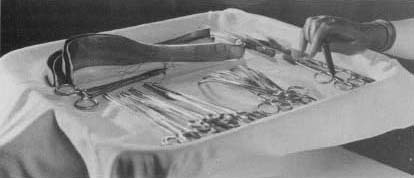Surgical instruments
Surgery has been performed since ancient times. The earliest recorded surgical operations were circumcision and trepanation. (Circumcision is the removal of the foreskin of the penis. Trepanation involves making a hole in the skull to relieve pressure and/or release spirits.) The earliest instruments used in these procedures were flint or obsidian (shiny stone) knives and saws. Stone Age skulls from around the world have been found with holes in them from trepanning. Primitive people also used knives to cut off fingers damaged in accidents.
Ancient Surgery
Ancient Mesopotamian (an area in southern Asia between the Tigris and Euphrates rivers) cultures practiced surgery to some degree. Small copper Sumerian (present-day southern Iraq) knives of about 3000 B.C. are believed to be surgical instruments. The Babylonian Code of Hammurabi of about 1700 B.C. mentions bronze lancets (sharp-pointed two-edged instruments used to make small incisions). Because the Code provided harsh penalties for poor medical treatment outcomes, surgery was prac-ticed only sparingly. Ancient Chinese and Japanese cultures were opposed to cutting into bodies, so surgical instruments were not used much.
By contrast, the ancient Egyptians recorded surgical procedures as early as 2500 B.C. Egyptians fashioned sharper instruments with a new metal, copper. They designed special tools to remove the brain from the skull when preparing bodies for mummification.
Hindus Excel at Surgery
The ancient Hindus of India excelled at surgery. The great surgical textbook, Sushruta Samhita, probably dates back to the last centuries B.C. This work described 20 sharp and 101 blunt surgical instruments. These instruments included forceps, pincers, trocars (sharp-pointed instruments fitted with a small tube), and cauteries (irons to heat and sear tissue). Most of these surgical tools were made of steel. The ancient Hindus also used lancets to carry out cataract surgery, scalpels to restore amputated noses via plastic surgery, and sharp knives to remove bladder stones. At about the same time, ancient Peruvians were performing trepanation. They left behind various surgical instruments, including scalpels and chisels made of obsidian.
Greek and Roman Surgery
The Greeks practiced surgery mostly on external parts of the body. They usually used forceps, knives, and probes. Bronze Roman surgical instruments found at Pompeii include a scalpel with a steel blade, spring and scissor forceps, a sharp hook, and shears. In the first century A.D. , Cel-cus

After ancient times, medical knowledge declined, and surgeons fell to a lowly status. In the absence of knowledge about antiseptics, surgery was highly risky. As a result, only the simplest and most urgent operations (such as amputations) using the most straightforward instruments were performed. A few physicians sought to spread knowledge of surgical procedures by publishing texts that illustrated surgical instruments. Most important among these men was the great French surgeon Ambroise Paré (1517-1590). Paré revived use of ligature and invented many surgical procedures and instruments. His inventions included the "crow's beak" to hold blood vessels while tying them off. Paré also perfected an instrument for cataract removal.
The Modern Era of Surgery
The era of modern surgery began with the introduction of both anesthesia and antiseptics/antisepsis in the mid-1800s. In 1878 Louis Pasteur (1822-1895) first suggested sterilizing surgical instruments. American doctor William Halsted (1852-1922) introduced sterile rubber gloves in the 1890s. The 1895 discovery of X-rays gave surgeons an invaluable diagnostic tool.
Great Refinements
Great refinements in surgery were made possible by the introduction of the operating microscope (thus allowing microsurgery) in the mid-twentieth century. The development of laser surgery in the 1970s was another great advancement. Both of these instruments permit operations on very delicate body structures. The increasingly sophisticated technology of the twentieth century makes ever-more-precise surgical tools possible. Among the newest devices are voice-activated operating microscopes and robotic surgical hands.
thanks alot!